Mountain Climber Will Cross has been living with type 1 diabetes since 1976 when he was diagnosed at the age of nine. Will was told that it was unlikely he would live to be 30 years old because of diabetes. In the 40 years since, he became passionate about high-altitude mountaineering and has ascended the highest peaks on all seven continents and walked to both the North and South Poles. Cross led expeditions to 15 unmapped and unexplored mountains in Greenland, Patagonia, Mountains of the Moon, the Sahara Desert, and the Thar Desert of India. Will seeks to get the message out that if he can control his diabetes in these conditions, no one should feel hindered by diabetes. Between expeditions, Will travels the nation as part of Tandem Diabetes Care’s Live Life in Full Color speaker series. This year he returned to Nepal twice as he pursues more high peaks. Here’s the story of his time on Mera, a 6,476 meter (21,247 ft) peak in the Mahalangur section of the Himalayas.1
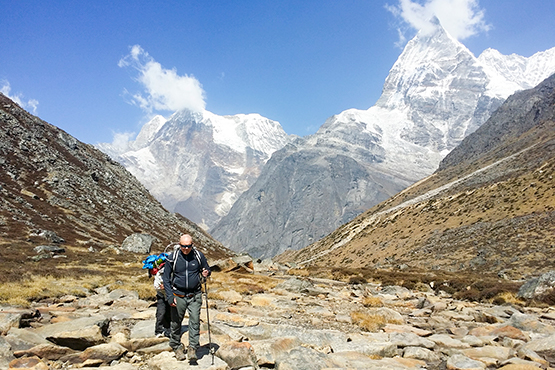
The view from the summit of Mera is one of the best in the Himalayas, with five 8,000-meter peaks visible, including Mount Everest, Lhotse, and Cho Oyu (all of which Will Cross has summited on previous expeditions).
Compared to some of the other mountains of the Himalayas, Will considers Mera an “approachable challenge,” citing high altitude as the main obstacle. “I was looking for a doable mountain,” he said. “One that was high enough to hurt, but not so dangerous that my sanity would be in question.”
This expedition had an academic purpose. Will is working with a physiology research group out of Harvard University that is evaluating the performance of the body with diabetes at altitude, and they used the climb to collect data.
The Mera climb is less technical than other climbs in the region. It requires less gear, allowing him to travel light. For this reason, Will felt that the Mera expedition would provide an intriguing opportunity to examine the effects of altitude on his heart rate, blood glucose, and insulin consumption throughout his month of travel.
“I was banking on some new insights about heart rates and blood glucose,” he said. “If I could measure my heart rate and perceived exertion as I climbed, I could, in theory, anticipate my insulin needs. Pre-treating, rather than reacting to glucose levels, would mean a smoother blood glucose profile, devoid of the peaks and valleys so common with a new routine.”
Preparing for the Climb
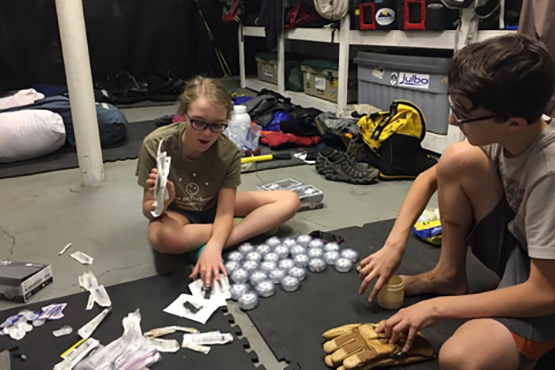
As they’ve done for the past 15 years, Will’s children Chloe and Max helped him pack. They counted two times more infusion sets than he should need. For a 45 day expedition he takes 45 pieces of each supply. If all goes well, he’ll only use half of them. They packed them in two large 20-kilo bags which share the space with packaged food. He plans for the worst.
“On a past expedition a donkey went over the edge, falling hundreds of feet into the river below,” he remembered. “He was just gone, and the problem was that so was the stack of food he was carrying. This is a big problem for me with diabetes. I pack a lot of extra gear and food so I can get in and out in one piece.”
As they packed as a family, they talked about past trips they’ve done together. The kids know most of the people that Will will see, they’ve stayed in some of the places he’ll stop. They also help make arrangements for a family friend, a sherpa living in Pittsburg, to look after the house and dog when Will leaves. It’s routine now.
Will left Pittsburgh and spent the next two days confined to an aircraft cabin until finally landing in Doha, the capital city of Qatar, for a brief respite. The Lamp Bear, a 23-foot canary yellow teddy bear sculpted from bronze that sits peacefully inside a lamp, greeted him in the grand foyer of Doha International Airport. It's a playful modern art piece intended to humanize the space around it and remind travelers of childhood or precious objects from home. Will pondered his decision and destination as he went from this spacious airport to the aged one in Kathmandu - a trip that’s hot from start to finish.
Dawa Sherpa met him on the other side of crowded customs in Kathmandu. The two men have known each other for over a decade, and Dawa has reliably provided services for all of Will’s expeditions. As a climbing agent, Dawa is responsible for permits, hiring sherpas, porters, cooks, internal transportation, food, fuel, logistics, tents, and oxygen. He’s become familiar with Will’s diabetes needs over the years too. Together they drove through the traffic of the capital city to a hotel where Will stores two large barrels of climbing gear between trips.
From Kathmandu Will and Dawa headed to the Tenzing–Hillary Airport, also known as Lukla Airport, renamed in honor of Sherpa Tenzing Norgay and Sir Edmund Hillary, the first people to reach the summit of Mount Everest. This tiny airport, where most people start the climb to Mount Everest Base Camp, is rated the most dangerous in the world by esteemed observers at National Geographic and The Discovery Channel.
“Imagine; cramped into a prop plane, approaching the uphill runway and having immovable mountains directly in front,” Will describes landing at Lukla. “You are flying towards the very objects that airplanes tend to avoid. It’s an exciting ride. And a relief to stand on firm ground after.”
Will got off the plane and met up with Tenzing Sherpa. Tenzing’s family is in Kathmandu to allow their children to attend school in the city, but Tenzing grew up in the high altitude Khumbu region and knows everyone. Tenzing was Will’s guide for the Mera climb, and it was the first they’d done together. Will briefed Tenzing on diabetes basics, focusing on how to recognize and treat hypoglycemia.
Tenzing quickly assigned a porter to Will’s gear bag. There are no roads in the Khumbu - all gear and necessities travel on someone's back, a donkey, or a yak. They moved on foot from Lukla to the two-day- away village of Namchee Bazaar.
This was the first trek that Will wore his new t:slim G4 Insulin Pump with its integrated Dexcom continuous glucose monitor (CGM). It was his first time at altitude with CGM data available to him.
“Wearing a CGM was critical and I had not done so on any other trip, largely due to concerns over accuracy, extra items to carry, and the durability of adhesives,” he said. “That my pump could now graph my CGM readings gave me the convenience and reassurance throughout the early trekking to the mountain.”
For example, hyperglycemia overnight affects everything. If he’s waking up in the middle of the night to pee, he doesn’t get the rest and recovery he needs.
“Now that I can see it on my pump, it makes a big difference and I’m confident and get better rest.”
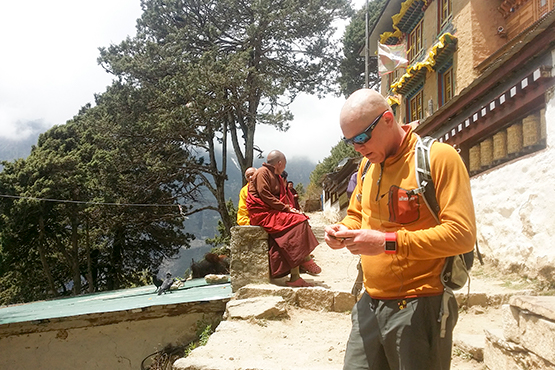
Namchee is the trading center for the entire region and hub for the Khumbu region. The city is carved into the hill in a circle of evenly-spaced steps and is popular with climbers for altitude acclimatization, last-minute gear purchases, internet access, and it serves the only good coffee in the region. These amenities inevitably make it a place where climbers might run into people they haven't seen in years, and it’s where Will stays with friends.
“Questions of doubt and trepidation often surface as the mind prepares for a Himalayan expedition,” says Will. “There’s the usual call of death, risk of freezing, and being buried alive, but on this one, I was wondering if I still had the juice to climb. My last two trips had not ended well. I was alive, but others were not.”
Every year for the past decade someone close to Will has died on the mountain. On his last trip, a French man had boiled water for him when he was weak from altitude sickness and made sure that Will recovered. Will ended his trip early because of his symptoms, but the French man continued on to the higher camp and perished two days later.
“My diabetes had become unpredictable above 6000 meters, making me weak and draining me of drive.” He wondered if Mera would mark the end of his high altitude career.
The Climb
When the weather was right, Will and Tenzing departed wearing cloth face masks to keep out the dust kicked up by animal traffic. It’s enough that it would inevitably seriously irritate his lungs for a whole month, but his goal was to fend off the deep cough until the summit.
He was plugged in; t:slim G4 Pump on one side, CGM on the other, and a heart monitor around his wrist. His pack was light, filled with a water bladder, extra layer, energy gels, and a camera. A porter carried a 15kg load of overnight gear and food to the high camp so Will could preserve his energy.
His pace along the trek was slow. Each day was tiring, but doable as he expected. He was able to, but not always interested in chatting. Six to eight hours of effort separated each tea house and small village where they spent the night. Electricity was limited and expensive so he relied on a solar panel to power his pump and glucometer.
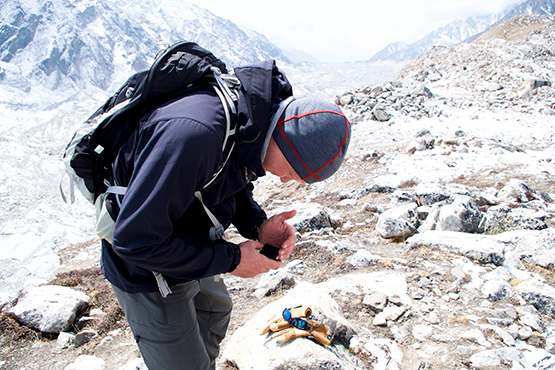
“From the data I soon learned that this tortoise-like ascent burnt glucose at a steady level and after a few hours started to pull the stored reserves from my body,” he said about the huge difference he experienced between two hours of exercise and 12 hours of exercise. Lowering his basal to 50% worked for a two hour routine, but a 12-hour day on the mountain may need 35% basal for as long as 10 hours.
“I was eating less and using less insulin than on previous outings, but I was moving more consistently and avoiding drastic highs and lows along the way,” he said.
The Summit
The final ascent is a 30-meter climb up a 60 degree snow dome, requiring a basic ice axe and crampons. At the top is a wide-open crevasse and the panoramic view of the other legendary peaks. Finally on top of the wide open summit, Will was relieved.
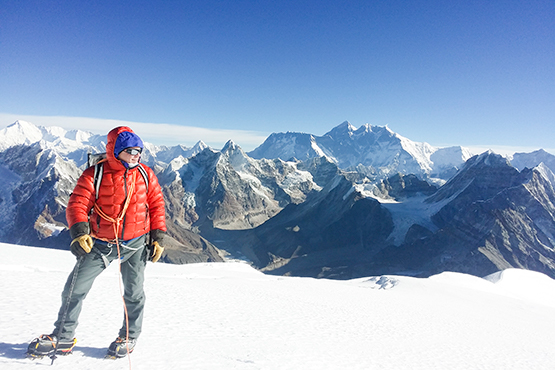
“I was really pleased to be functioning above 6000 meters again,” he said. “It’s a great view of course, but the deep satisfaction continues to brew long after the summit.”
On the way down he found himself thinking about what was next.
“Relearning how my diabetes works at altitude was a relief and an inspiration to continue climbing.”
We look forward to hearing more from Will as he pursues more high peaks.
Article by Will Cross and Blair Ryan.
1Rapid changes in altitude or gravity can affect insulin delivery and cause injury. As a reminder, avoid exposure of your Tandem Pump to temperatures below 40°F (5°C) or above 99°F (37°C), as insulin can freeze at low temperatures or degrade at high temperatures. CHECK your blood glucose using a blood glucose meter following a gradual elevation change of up to 1,000 feet, such as when snow skiing or driving on a mountain road. Delivery accuracy can vary up to 15% until 3 units of total insulin have been delivered or elevation has changed by more than 1,000 feet. Changes in delivery accuracy can affect insulin delivery and cause injury. Tandem insulin pumps have been tested at altitudes up to 10,000 feet at standard operating temperatures.
From time to time, we may pass along: suggestions, tips, or information about other Tandem Insulin Pump user experiences or approaches to the management of diabetes. However, please note individual symptoms, situations, circumstances and results may vary. Please consult your physician or qualified health care provider regarding your condition and appropriate medical treatment. Please read the Important Safety Information linked below before using a Tandem Diabetes Care product.